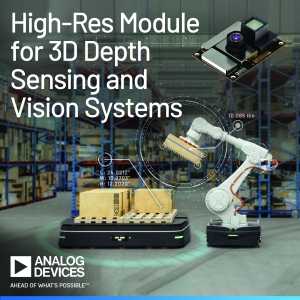The Sensors Converge conference, held June 27-29, showcased the latest sensors and sensor solutions, including those facilitating IoT connectivity. These innovative sensors target a wide range of applications, from automotive and industrial to consumer electronics and mobile devices.
Here is a selection of these innovations on display at this year's show.
Automotive sensors

Magnetic position sensors Allegro A331100-A33115. Click to enlarge image. (Source: Allegro MicroSystems)
Allegro MicroSystems, Inc. introduced its A33110 and A33115 magnetic position sensors at Sensors Converge 2022. The new sensors are the first to use vertical Hall effect technology (VHT) and tunnel magnetoresistance (TMR) technology in a single sensor. These sensors, housed in 14-lead TSSOP packages, are designed for advanced driver assistance systems.
Allegro MicroSystems describes the combined VHT + TMR offering as "the best heterogeneous redundant sensor solution" and "a significant step towards providing the reliability required for advanced levels of vehicle automation."
360˚ angle sensors provide magnetic angle measurements via primary (TMR) and secondary (vertical Hall) sensors. Each is processed by two independent channels with independent controllers and temperature sensors. The primary TMR channel and the secondary channel have 14-bit and 10-bit noiseless resolutions, respectively.
This configuration provides the high level of safety and diagnostics required for automated driving, including inter-channel chip angle comparison and independent processing in digital signal paths without shared digital resources, the company said.
In addition, these sensors meet the Automotive Safety Integrity Level-D (ASIL-D) standard with heterogeneous redundancy, which reduces the probability of dependent failures thanks to VHT and TMR technologies, according to Allegro MicroSystems.

Inductive position sensor LX34070 from Microchip Technology. Click to enlarge image. (Source: Microchip Technology)
Microchip Technology Inc. announced the expansion of its family of inductive position sensors in the electric vehicle motor control market with the launch of the LX34070 IC. Designed for electric motor control applications, the new position sensor includes features that make it functionally safe and ready to meet ISO 26262 in ASIL-C classification. The LX34070 is also suitable for a number of commercial, industrial and medical applications.
The inductive position sensor housed in a 14-pin TSSOP package is said to provide lighter, smaller, and more reliable motors compared to Hall-effect position sensors and older magnetic resolver solutions by eliminating magnet cost, weight, and size.
The LX34070 provides a voltage range of 4.5 to 5.5 V with a maximum voltage of up to 18 V. The extended operating temperature range is from –40˚C to 160˚C. Calibration can be done using the VIN signal or the GPIO digital signal pins. In addition to ASIL-C compliance, the position sensor provides AEC-Q100 level 0 certification.
The LX34070 inductive position sensor offers several advantages over magnetic resolvers and linear differential voltage converters at a fraction of the cost, Microchip said.
The LX34070 can be combined with Microchip's other functional safety-ready 8-bit AVR and PIC microcontrollers, 32-bit microcontrollers and dsPIC digital signal controllers to further optimize motor control designs, said Fanny Duvenhage, vice president of Microchip's mixed-signal division. and a linear analog business unit.
Industrial sensors

Analog Devices ADTF3175 iToF module. Click to enlarge image. (Source: Analog Devices Inc.)
Analog Devices Inc. (ADI) announced the industry's first high-resolution, industrial-grade indirect time-of-flight (iToF) module for 3D depth measurement and vision systems. The ADTF3175 module allows cameras and sensors to perceive 3D space with a resolution of 1 megapixel. It offers accurate ±3mm iToF technology available for machine vision applications including industrial automation, logistics, healthcare and augmented reality.
Housed in a 42 × 31 × 15.1 mm module, the ADTF3175 is a scalable and calibrated depth system that can be integrated into 3D sensing and vision systems. This eliminates the need to develop specialized optics or solve electromechanical integration problems, which facilitates rapid time-to-market by simplifying the sensor design process, Analog Devices said.
The ToF thermal imager with a resolution of 1024 × 1024 pixels and 3.5 × 3.5 μm pixels provides a viewing angle of 75 × 75 degrees and a depth range of 0.4 to 4 meters. It supports a four-channel MIPI CSI-2 Tx interface (1.5 Gbps per channel) for image data output, and a four-wire SPI serial interface and two-wire I2C for programming and operation control.
The main characteristics include an infrared radiation source with optics, a laser diode and a driver, as well as a receiving path with a lens and an optical bandpass filter. The module also contains flash memory for calibration, firmware storage, and power regulators to generate local supply voltage. It comes pre-programmed with multiple operating modes for long and short range.

Superior Sensor Technology multi-range differential pressure sensors. Click to enlarge image. (Source: Superior Sensor Technology)
Superior Sensor Technology offers its Multi-Range technology, which allows a single differential pressure sensor to support up to eight different pressure ranges in its range of differential pressure sensors. According to the company, this patented technology eliminates the need to create and design multiple differential pressure sensors, while reducing design complexity and lowering system manufacturing costs. These sensors find applications in heating, ventilation, ventilation, ventilation and air conditioning systems, as well as in industry and medicine.
One example is the HV210 for measuring airflow and velocity in HVAC equipment. The HV210 can be set to operate in seven different pressure ranges, from 0.1 in. H2O to 10 in. H2O, with accuracy within 0.10% in each selected range.
Each pressure range is calibrated at the factory to ensure no degradation of overall error range, accuracy and stability regardless of the range selected, the company said. The pressure range can be programmed with a single software command, making it easy to change the range for different product applications. Technicians can also select them "on the fly" in the field.

u-blox M10 GNSS module. Click to enlarge image. (Source: u-blox)
U-blox has announced its smallest series of Global Navigation Satellite System (GNSS) modules, the u-blox MIA-M10, for developing compact asset tracking solutions. Built on the ultra-low-power u-blox M10 GNSS platform, the MIA-M10 is designed for limited battery-powered asset tracking devices, including people, pets, and livestock trackers, as well as industrial sensors and consumer products.< /p>
About half the size of competing products, the 4.5 x 4.5mm MIA-M10 features power-saving modes that can double battery life by balancing positioning accuracy and power consumption. It simultaneously receives four GNSS groups (GPS, Galileo, BeiDou and GLONASS) for maximum satellite signal availability, and thanks to its high RF sensitivity, the module provides positioning performance for solutions with small antennas, as well as for devices operating in weak signal conditions. In environments such as deep urban canyons, the company said.
The MIA-M10 is available in two product variants. The MIA-M10Q is designed for battery-powered tracking devices with a very limited footprint. A second product variant, the MIA-M10C, is aimed at customers who need more flexibility to combine the module with an active or custom antenna scheme, the company said.
The ready-to-use chip-sized GNSS module requires no external components. The first samples will be available in July 2022.
Household electronics
The BOS0614 isodriver chip from Boréas Technologies. Click to enlarge image. (Source: Boréas Technologies)
Boréas Technologies has released the BOS0614, a four-channel piezo-tactile driver with an integrated sensor designed to enhance the gaming experience on smartphones. The BOS0614 is based on the company's patented CapDrive technology, which provides high-definition tactile feedback and integrated force sensing for the smallest devices while reducing power consumption.
The quad-channel BOS0614 controls up to four actuators simultaneously and combines customizable haptics, a high-resolution force sensor and ultra-low latency for a more immersive experience for mobile gamers, the company said.
Key Features The CapDrive 60V piezo driver includes a force sampling rate of 10 kS/s, a detection delay of 100 µs, a force measurement resolution of 220 µV, and a wide supply voltage range from 3 V to 5.5 V. Other features include a zero power sensor for wake-up , an I3C/I2C digital communication interface, a deep FIFO interface, and four GPIOs. The BOS0614 is housed in a WLCSP package (2.1 × 2.5 × 0.5 mm).

HS4XXX relative humidity sensor. Click to enlarge image. (Source: Renesas Electronics)
Renesas Electronics Corp. introduced the HS4XXX family of relative humidity and temperature sensors and the ZSSC3281 sensor signal shaping (SSC) chip for amplifying, digitizing and correcting sensor signals. These new products complement the company's portfolio of microprocessors, embedded artificial intelligence solutions and the Quick-Connect IoT development platform.
The HS4XXX family provides high accuracy, fast measurement response time and ultra-low power consumption in a small package size. Key features include standard temperature sensor accuracy of ±0.2˚C and high precision relative humidity measurement of ±1.5% RH.
The sensors also provide ultra-low sleep current of 0.010 µA and very low current consumption of 0.3 µA on average for 8-bit resolution with 3.3 V supply. The devices are housed in a 2.5 × 2.5 × 0.9 mm style package DFN with eight LGAs. They can be used in a variety of applications, including portable devices and products designed for harsh environments.
According to Renesas, the ZSSC3281 SSC provides a dual-speed mode for the highest accuracy with the fastest refresh rate. It includes a dual-channel analog front-end as well as an integrated Arm-based MCU with built-in math to process the sensor signal. Other features include a measurement scheduler, advanced interrupt and diagnostic functions, and multiple digital interfaces, including I²C, SPI, and a single-wire interface. It targets high-tech applications, including industrial, medical and consumer systems.
TDK Corporation announced that its InvenSense ICP-20100, the latest generation of SmartPressure MEMS barometric pressure sensors, is now in mass production and has passed NextNav certification. Launched in 2021, the NextNav Certified process independently verifies the accuracy of InvenSense sensor measurements. The ICP-20100 is believed to be the lowest power barometric pressure sensor to receive this certification.
The ICP-20100 can operate over a wide temperature range and provide the measurement accuracy required for a variety of applications, including 3D geolocation and emergency location service (E911), indoor/outdoor mobile navigation, sports and fitness tracking, and altitude hold in drones . "With extremely low power consumption, the sensor provides extended battery life for always-on applications," TDK said.
The ICP-20100 device combines a barometric pressure and temperature sensor in a 2.0 × 2.0 × 0.8 mm housing. The device offers multiple input voltage levels, including 1.2V, 1.8V, and 3.3V, and a choice of I²C, I3CSM, and SPI interfaces. The ICP-20100 can be configured to achieve ultra-low noise or ultra-low power consumption. With ultra-low noise pressure measurement capabilities, the ICP-20100 can detect height changes of less than 5 cm.
The DK-20100 development kit and the EV_ICP-20100 evaluation platform are available. along with the necessary software. Other devices in the SmartPressure family include the ICP-10125, ICP-10101, and ICP-10111 pressure sensors.
Demonstrations
Excelitas Technologies Corporation demonstrated its latest LiDAR technologies, radon detectors and thermal infrared sensors. The Excelitas/Elmos live demo featured a 16-channel solid-state LiDAR demonstrator showcasing the latest generation of Excelitas pulsed laser diodes assembled on an Elmos driver chip in combination with an Elmos Single Photon Avalanche Diode (SPAD) array and C-mount lens. The demonstration demonstrates the capabilities of both Excelitas powerful lasers (150 W at 50 A) and the laser module, as well as the Elmos laser driver and SPAD array for use in LiDAR system applications to generate 3D point clouds.
Excelitas also demonstrated its BluePyro smart home module, using SMD DigiPyro for motion detection with built-in Bluetooth connectivity. The advanced sensor module has a two-element low-power SMD DigiPyro Excelitas PYD 2592 integrated into the reference design with a Bluetooth interface. Target applications include low-power and low-cost IoT applications in the smart home and consumer electronics sectors.
On display at the Digi-Key Electronics booth was the medical version of Excelitas' multi-functional CaliPile sensor, the TPiS 1T 1386 L5.5 H. Designed for medical temperature measurement requirements, the thermopile has integrated signal processing and is factory calibrated to provide medically accurate readings. measurements without the need for re-calibration after integration into the final device. The non-contact temperature measurement demonstration highlighted the product's suitability for industrial applications, including remote temperature measurement, fast remote overheat protection, mid-field human presence detection, and far-field human motion detection.
Also at the exhibition was a series of Excelitas VTH21 photodiodes for radon detection. According to the company, they are offered in chip form for optimal detection of alpha particles, such as for radon detection. These photodiodes are available in two standard chip geometries, including a large active area of 5 × 5 mm and 10 × 10 mm for maximum low-level emission detection, and have a spectral response from 400 nm to 1100 nm.

Beacon IoT Powercast and Inplay sensor system platform. Click to enlarge image. (Source: Powercast Corp.)
Powercast Corp., a provider of RF wireless power technology, and InPlay, an inventor of NanoBeacon System-on-Chip (SoC) technology, are collaborating to create a platform to develop battery-free, maintenance-free, IoT sensor systems that can be powered over long distances of up to 120 feet , previously documented to power sensors over 80 feet.
Powercast and InPlay demonstrated how Powercast's RF-to-DC power harvesting technology can power the InPlay IN100 active Bluetooth sensor, the company's first NanoBeacon SoC. The IN100 can be attached to almost anything for real-time location monitoring and paired with sensors to monitor conditions such as light, humidity and temperature, the company said. Plus, it's app-configurable and requires no software. The SoC transmits data up to 300 feet away and has a software-defined radio network that enables tens of thousands of IoT devices to be connected.
Powercast's far-field wireless technology powers the NanoBeacon IN100 from up to 120 feet away from a commercially available PowerSpot transmitter, turning on the beacon signal every minute. According to the company, NanoBeacon's low-power design enables fast start-up and data transmission using only microwatts of power.
The new distance gain is thanks in part to Powercast's new reference design for the PCC110 Powerharvester chip and the accompanying PCC210 boost. converter that collects radio frequencies together from the air with an efficiency of up to 75%.
Learn more about Allegro MicroSystemsAnalog DevicesMicrochip Technology PowercastRenesas Electronics AmericaTDKu-blox
Source: electronicproducts.com










